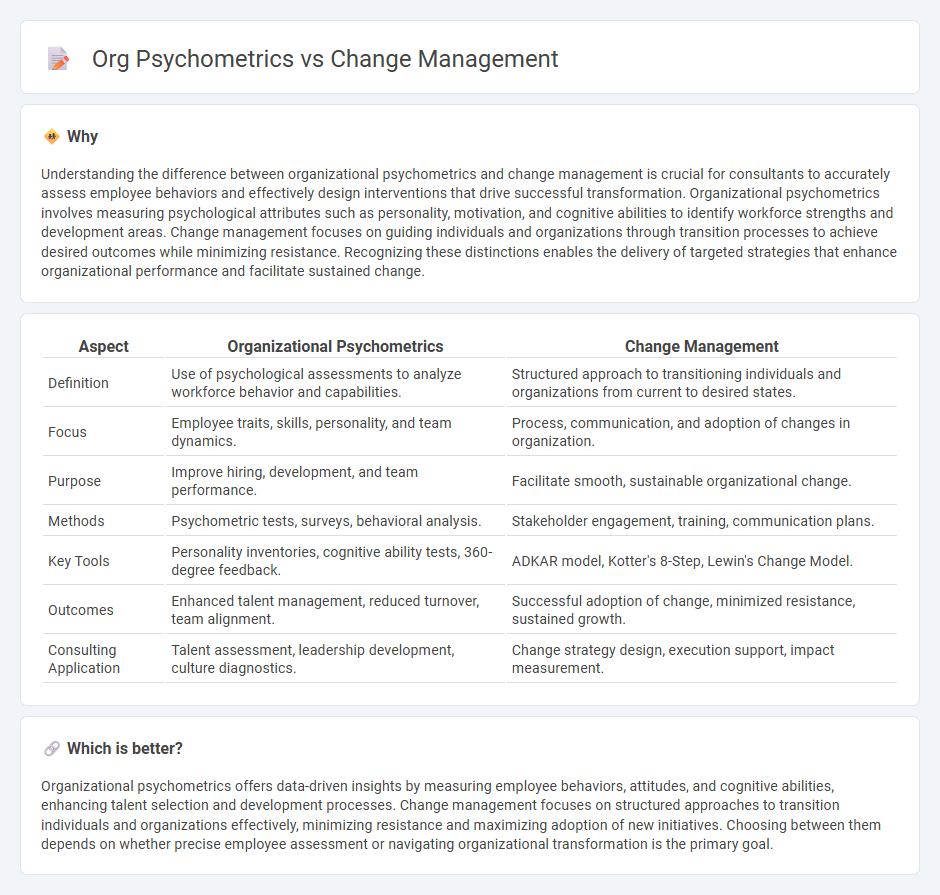
Organizational psychometrics employs data-driven assessments to measure employee traits, behaviors, and workplace dynamics, enhancing talent selection and development processes. Change management focuses on strategic planning and stakeholder engagement to ensure smooth transitions during organizational transformations and minimize resistance. Discover how integrating psychometrics with change management can optimize organizational performance and employee adaptation.
Why it is important
Understanding the difference between organizational psychometrics and change management is crucial for consultants to accurately assess employee behaviors and effectively design interventions that drive successful transformation. Organizational psychometrics involves measuring psychological attributes such as personality, motivation, and cognitive abilities to identify workforce strengths and development areas. Change management focuses on guiding individuals and organizations through transition processes to achieve desired outcomes while minimizing resistance. Recognizing these distinctions enables the delivery of targeted strategies that enhance organizational performance and facilitate sustained change.
Comparison Table
| Aspect | Organizational Psychometrics | Change Management |
|---|---|---|
| Definition | Use of psychological assessments to analyze workforce behavior and capabilities. | Structured approach to transitioning individuals and organizations from current to desired states. |
| Focus | Employee traits, skills, personality, and team dynamics. | Process, communication, and adoption of changes in organization. |
| Purpose | Improve hiring, development, and team performance. | Facilitate smooth, sustainable organizational change. |
| Methods | Psychometric tests, surveys, behavioral analysis. | Stakeholder engagement, training, communication plans. |
| Key Tools | Personality inventories, cognitive ability tests, 360-degree feedback. | ADKAR model, Kotter's 8-Step, Lewin's Change Model. |
| Outcomes | Enhanced talent management, reduced turnover, team alignment. | Successful adoption of change, minimized resistance, sustained growth. |
| Consulting Application | Talent assessment, leadership development, culture diagnostics. | Change strategy design, execution support, impact measurement. |
Which is better?
Organizational psychometrics offers data-driven insights by measuring employee behaviors, attitudes, and cognitive abilities, enhancing talent selection and development processes. Change management focuses on structured approaches to transition individuals and organizations effectively, minimizing resistance and maximizing adoption of new initiatives. Choosing between them depends on whether precise employee assessment or navigating organizational transformation is the primary goal.
Connection
Organizational psychometrics provides precise measurement tools to assess employee attitudes, behaviors, and cultural alignment, which are critical inputs for effective change management strategies. By leveraging psychometric data, consultants can identify resistance levels, tailor communication plans, and track the impact of change initiatives to ensure successful adoption. This data-driven approach enhances organizational agility and supports sustainable transformation.
Key Terms
Change management:
Change management involves systematically applying processes, tools, and techniques to lead organizational transformation, ensuring employee engagement and minimizing resistance. It emphasizes strategic planning and communication to facilitate smooth transitions and sustain change benefits. Explore how change management integrates with organizational psychometrics to enhance change success.
Stakeholder Engagement
Change management ensures successful project adoption through structured stakeholder engagement strategies, emphasizing clear communication and resistance mitigation. Organizational psychometrics provides data-driven insights into stakeholder behaviors, attitudes, and readiness by leveraging assessments such as personality tests and cultural diagnostics. Explore how integrating these approaches can optimize stakeholder engagement and drive transformative success.
Communication Plan
Change management emphasizes structured communication plans to facilitate smooth transitions by clearly outlining message content, timing, and channels. Organizational psychometrics leverages data-driven insights into employee behavior and attitudes to tailor communication strategies that enhance engagement and reduce resistance. Explore how integrating psychometric assessments into change communication plans can drive organizational success.
Source and External Links
What is Change Management? - IBM - Change management is an organizational method to communicate and implement change including managing both people and processes, emphasizing support throughout the transition and embedding change into company culture for successful adoption.
What is Change Management? Definition & Process - WalkMe - Change management involves a coordinated approach that includes clear vision, training, managing resistance, and monitoring to ensure smooth implementation and sustainability of organizational change.
What is Change Management? Organizational, Process ... - ASQ - Change management includes defining and assessing change risks, planning within a project framework, and engaging leadership and employees through communication and teamwork to ensure effective implementation and adaptation.
 dowidth.com
dowidth.com